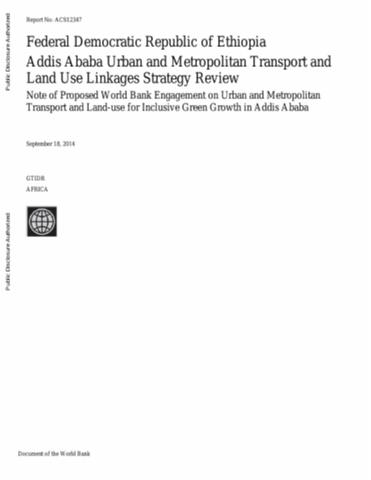Resource information
Since 2004 Ethiopia has experienced strong and generally broad-based real economic growth averaging 10.7 percent per annum. It is one of the most populous countries in the world, but it is not highly urbanized. Nevertheless, urbanization in Ethiopia is taking place rapidly, and is expected to increase over the coming few decades. Addis Ababa, is its commercial and political center and exemplary of the rapid urban growth of Ethiopia. The rapid urban and metropolitan growth in Addis Ababa is exacerbated by poor planning and land-use, inadequate infrastructure, and chronic housing shortage. A key challenge for housing in the Addis Ababa metropolitan area, and, indeed, of planning in general, is that lack of coordination with transportation. The one factor that has mitigated the growth in congestion has been that motorization rates in Addis Ababa are very low by global standards. Over the past seven years, Addis Ababa has been making a concerted effort to improve the urban transport situation, largely through large investments in new infrastructure, including roads, a new Light Rail Transit (LRT) system (under construction) and plans for a new Bus Rapid Transit (BRT) system, and improved standards and practices for improving and integrating pedestrian facilities in major transport capital projects. It has invested heavily in its road asset stock, with 26 percent of its capital investment budget dedicated to transport. These investments in the road network may provide less economic and mobility value for residents than their planners may have intended, for four reasons. Indeed, at the current low rates of motorization, the frequent and ubiquitous congestion in the city suggests substantial shortcomings in how traffic is managed, rather than a fundamental mismatch between transport supply and demand. In order to improve public transport, for the city’s largely non-motorized population, substantial investments in mass transport network have been made or identified. The current public transport provision/operation has a number of weaknesses, with governance being a critical one. Even though most trips in Addis Ababa are made by walking, facilities for pedestrians tend to be inadequate and substandard. Integrating transport with land-use development has also proven to be very difficult in Addis Ababa. In terms of overall urban development, although the Ethiopian government is making attempts at planning and catering for the rapid urban growth, urbanization still takes place largely in an unplanned/informal way. In recent years, the rate of spatial expansion of the city is outpacing the rate of population growth, resulting in a less than efficient overall physical form.


